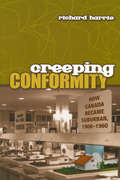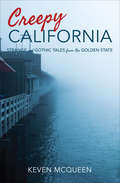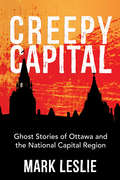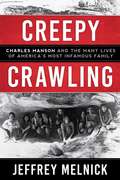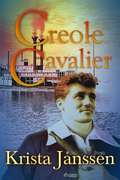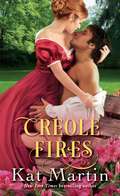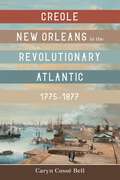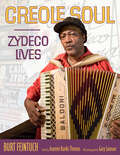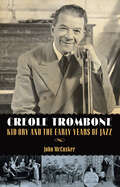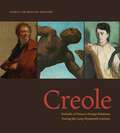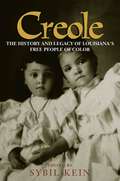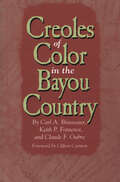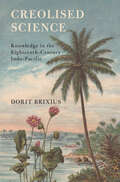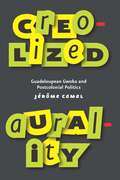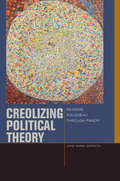- Table View
- List View
Creek Walking: Growing Up in Delaware in the 1950s
by Jacqueline JonesNoted historian uses her own family history and childhood memories to explore the history and culture of a small town in Delaware with attention to race and class dynamics.
Creepers
by David MorrellFive urban explorers meet up and begin preparations to break into the abandoned Paragon Hotel. But after finding their way inside, it becomes clear that they will get more than they bargained for.
Creeping Conformity
by Richard HarrisCreeping Conformity, the first history of suburbanization in Canada, provides a geographical perspective - both physical and social - on Canada's suburban past. Shaped by internal and external migration, decentralization of employment, and increased use of the streetcar and then the automobile, the rise of the suburb held great social promise, reflecting the aspirations of Canadian families for more domestic space and home ownership.After 1945 however, the suburbs became stereotyped as generic, physically standardized, and socially conformist places. By 1960, they had grown further away - physically and culturally - from their respective parent cities, and brought unanticipated social and environmental consequences. Government intervention also played a key role, encouraging mortgage indebtedness, amortization, and building and subdivision regulations to become the suburban norm. Suburban homes became less affordable and more standardized, and for the first time, Canadian commentators began to speak disdainfully of 'the suburbs,' or simply 'suburbia.' Creeping Conformity traces how these perceptions emerged to reflect a new suburban reality. Disclaimer: Two images removed at the request of the rights holder.
Creepy California: Strange and Gothic Tales from the Golden State
by Keven McQueenThis &“fun primer on California&’s macabre and eccentric history&” explores true crimes, paranormal reports, and other curious tales from the Pacific Coast (Paul Koudounaris). California has many famous wonders—the beaches, vineyards, and glamorous neighborhoods are all well documented in guidebooks. But there are darker wonders here as well—the kind seldom shared with outsiders. In Creepy California historian Kevin McQueen explores strange tales of unexplained deaths, intentional live burials, true crimes, and ghosts who haunt the Pacific Coast. From the uncanny to the outright paranormal, this chronicle of oddities includes the story of a coroner who &“borrowed&” the stylish clothes of a dead man and then sold the corpse&’s head to a doctor; a rare look inside Stanford University&’s secret collection of occult memorabilia; the tale of a haunted, two-story house in San Francisco that was painstakingly moved across town in an effort to dislodge its ghostly tenants; a profile of a lonesome Fort Bragg resident who carved a family for himself out of wood; and many others. An intriguing look at the Golden State&’s bounty of unsettling curiosities, Creepy California promises to keep you guessing what other mysteries lurk in the fog.
Creepy Capital: Ghost Stories of Ottawa and the National Capital Region
by Mark LeslieA supernatural tour of the Ottawa region with ghostwatcher Mark Leslie as your guide. Come along with paranormal raconteur Mark Leslie as he uncovers first-person accounts of ghostly happenings throughout Ottawa and the surrounding towns — the whole region is rife with ghostly encounters and creepy locales. Discover the doomed financier who may be haunting the Château Laurier. Experience the eerie shadows and sounds at the Bytown Museum. Listen to the echoing howls of former prison inmates at the Nicholas St. Hostel. And feel the bitter sadness of the ghost of Watson’s Mill in Manotick. You’ll marvel at the multitude of ghosts that walk the streets and historic landmarks of Canada’s capital.
Creepy Crawling: Charles Manson and the Many Lives of America's Most Infamous Family
by Jeffrey Melnick"Creepy crawling" was the Manson Family's practice of secretly entering someone's home and, without harming anyone, leaving only a trace of evidence that they had been there, some reminder that the sanctity of the private home had been breached. Now, author Jeffrey Melnick reveals just how much the Family creepy crawled their way through Los Angeles in the sixties and then on through American social, political, and cultural life for close to fifty years, firmly lodging themselves in our minds. Even now, it is almost impossible to discuss the sixties, teenage runaways, sexuality, drugs, music, California, and even the concept of family without referencing Manson and his "girls." Not just another history of Charles Manson, Creepy Crawling explores how the Family weren't so much outsiders but emblematic of the Los Angeles counterculture freak scene, and how Manson worked to connect himself to the mainstream of the time. Ever since they spent two nights killing seven residents of Los Angeles-what we now know as the "Tate-LaBianca murders"-the Manson family has rarely slipped from the American radar for long. From Emma Cline's The Girls to the recent TV show Aquarius, the family continues to find an audience. What is it about Charles Manson and his family that captivates us still? Author Jeffrey Melnick sets out to answer this question in this fascinating and compulsively readable cultural history of the Family and their influence from 1969 to the present.
Creepy Kentucky: Strange Stories from the Bluegrass State (American Legends)
by Mr. Keven McQueenThe Eerie and Ominous in Kentucky Kentucky is no stranger to strange occurrences. From weird encounters with the Grim Reaper to local graveyard dogs, the Bluegrass State has its share of odd stories. Learn about local ghosts who've haunted areas for years. Encounter body snatchers and some very odd modes of death. Go on the hunt for Daniel Boone's bones and witness the marvelous twisting tombstone. Witness the people who uncannily predicted their own death. Author Keven McQueen details these creepy stories and more.
Creole Cavalier
by Krista JanssenA Tennessee backwoods beauty. A creole gentleman hiding his true allegiance. Against all odds, they find a dazzling passion that transcends time and warfare. Country girl, Rebecca Gordon proves she is the best shot in Tennessee when she wins a sharpshooter contest. On her deathbed, her mother reveals that Rebecca's real father is a Creole gentleman from New Orleans. As the Americans prepare for war against the British, Rebecca travels down the Mississippi to New Orleans in search of her heritage. There she meets American spy, Captain Blaine Caldwell and a passionate attraction flames between them. When Rebecca falls into the hands of a notorious Madam of Pleasure, intrigue and danger close around her, and Blaine must find a way to extricate his innocent beloved. As the British approach the city, Blaine is captured, and Rebecca must use all her skills in a desperate gamble to save his life and the love they are destined to share.
Creole Fires (Southern Series #1)
by Kat MartinThe Louisiana sun beat mercilessly on Nicole St. Claire just as fate, too, had been merciless. The once wealthy, flirtatious belle stood on the auction block to be sold as a servant. Her sensual figure disguised, her glorious titian hair disheveled, she looked like a waif, but she was all woman, trembling when she recognized the highest bidder--idol of her childhood dreams, the owner of plantation Belle Chene. A man of blazing passion, Alex du Villier bought the girl out of pity, but her aqua eyes stirred his soul and her body ignited his blood. She would be the perfect mistress to make him forget his coming marriage to a cold, haughty heiress. Now he intended to teach this innocent beauty that although he had purchased her freedom, he could steal her heart. An affair of burning desires. . . . Under a Creole moon their passion became a wildfire neither could control, driving them to heart-wrenching choices of silken sin. . . or freedom and love.
Creole Gentlemen: The Maryland Elite, 1691-1776 (New World in the Atlantic World)
by Trevor BurnardExamining the lives of 460 of the wealthiest men who lived in colonial Maryland, Burnard traces the development of this elite from a hard-living, profit-driven merchant-planter class in the seventeenth century to a more genteel class of plantation owners in the eighteenth century. This study innovatively compares these men to their counterparts elsewhere in the British Empire, including absentee Caribbean landowners and East Indian nabobs, illustrating their place in the Atlantic economic network.
Creole Indigeneity: Between Myth and Nation in the Caribbean
by Shona N. JacksonDuring the colonial period in Guyana, the country&’s coastal lands were worked by enslaved Africans and indentured Indians. In Creole Indigeneity, Shona N. Jackson investigates how their descendants, collectively called Creoles, have remade themselves as Guyana&’s new natives, displacing indigenous peoples in the Caribbean through an extension of colonial attitudes and policies.Looking particularly at the nation&’s politically fraught decades from the 1950s to the present, Jackson explores aboriginal and Creole identities in Guyanese society. Through government documents, interviews, and political speeches, she reveals how Creoles, though unable to usurp the place of aboriginals as First Peoples in the New World, nonetheless managed to introduce a new, more socially viable definition of belonging, through labor. The very reason for bringing enslaved and indentured workers into Caribbean labor became the organizing principle for Creoles&’ new identities.Creoles linked true belonging, and so political and material right, to having performed modern labor on the land; labor thus became the basis for their subaltern, settler modes of indigeneity—a contradiction for belonging under postcoloniality that Jackson terms &“Creole indigeneity.&” In doing so, her work establishes a new and productive way of understanding the relationship between national power and identity in colonial, postcolonial, and anticolonial contexts.
Creole New Orleans in the Revolutionary Atlantic, 1775–1877
by Caryn Cossé BellNowhere in the United States did the Age of Democratic Revolution exert as profound an influence as in New Orleans. In 1809–10, refugees of the Haitian Revolution doubled the size of the city. In 1811, hundreds of Saint-Dominguan, African, and Louisianan plantation workers marched downriver toward the city in the nation’s largest-ever slave revolt. Itinerant revolutionaries from throughout the Atlantic congregated in New Orleans in the cause of Latin American independence. Together with the refugee soldiers of the Haitian Revolution (both Black and white), their presence proved decisive in the Battle of New Orleans. After defeating the British, the soldiers rejoined the struggle against Spanish imperialism. In Creole New Orleans in the Revolutionary Atlantic, 1775–1877, Caryn Cossé Bell sets forth these momentous events and much more to document the revolutionary era’s impact on the city.Bell’s study begins with the 1883 memoir of Hélène d’Aquin Allain, a French Creole and descendant of the refugee community, who grew up in antebellum New Orleans. Allain’s d’Aquin forebears fought alongside the Savarys, a politically influential free family of color, in the Haitian Revolution. Forced from Saint-Domingue/Haiti, the allied families retreated to New Orleans. Bell’s reconstruction of the d’Aquin family network, interracial alliances, and business partnerships provides a productive framework for exploring the city’s presence at the crossroads of the revolutionary Atlantic.Residing in New Orleans in the heyday of French Romanticism, Allain experienced a cultural revolution that exerted an enormous influence on religious beliefs, literature, politics, and even, as Bell documents, the practice of medicine in the city. In France, the highly politicized nature of the movement culminated in the 1848 French Revolution with its abolition of slavery and enfranchisement of freed men and women. During the Civil War and Reconstruction, the Afro-Creole leaders of the diasporic community pointed to events in France and stood in the forefront of the struggle to revolutionize race relations in their own nation. As Bell demonstrates, their cultural and political legacy remains a formidable presence in twenty-first-century New Orleans.
Creole Religions of the Caribbean, Third Edition: An Introduction (Religion, Race, and Ethnicity)
by Lizabeth Paravisini-Gebert Margarite Fernández OlmosAn updated introduction to the religions developed in the Caribbean regionCreole Religions of the Caribbean offers a comprehensive introduction to the overlapping religions that have developed as a result of the creolization process. Caribbean peoples drew on the variants of Christianity brought by European colonizers, as well as on African religious and healing traditions and the remnants of Amerindian practices, to fashion new systems of belief. From Vodou, Santería, Regla de Palo, the Abakuá Secret Society, and Obeah to Quimbois and Espiritismo, the volume traces the historical–cultural origins of the major Creole religions, as well as the newer traditions such as Rastafari.This third edition updates the scholarship by featuring new critical approaches that have been brought to bear on the study of religion, such as queer studies, environmental studies, and diasporic studies. The third edition also expands the regional considerations of the diaspora to the US Latinx communities that are influenced by Creole spiritual practices, taking into account the increased significance of material culture?art, music, literature, and healing practices influenced by Creole religions.
Creole Soul: Zydeco Lives (American Made Music Series)
by Burt FeintuchCreole Soul: Zydeco Lives is an exquisitely photographed volume of interviews with contemporary zydeco musicians. Featuring the voices of zydeco’s venerable senior generation and its current agents of change, this book celebrates a musical world full of passion, energy, cowboy hats and boots, banging bass, horse trailers, joy, and dazzling dance moves. Author Burt Feintuch captures an important American music in the process of significant—and sometimes controversial—change. Creole Soul draws us into conversations with zydeco musicians from Texas and Louisiana, most of them bandleaders, including Ed Poullard, Lawrence “Black” Ardoin, Step Rideau, Brian Jack, Jerome Batiste, Ruben Moreno, Nathan Williams Jr., Leroy Thomas, Corey Ledet, Sean Ardoin, and Dwayne Dopsie. Some of the interviewees represent the contemporary scene and are among today’s most popular performers along the Creole Corridor. Others are rooted in older French music forms and are especially well qualified to talk about zydeco’s origins. The musicians speak freely, whether discussing the death of a famed musician or describing a memorable performance, such as when Boozoo Chavis played the accordion while dripping blood on stage shortly after a freak barbeque-building accident that sliced off parts of two of his fingers. They address the influence of rap on today’s zydeco music and discuss how to pass music along to a younger generation—and how not to. They weigh the merits of the old-time zydeco clubs versus today’s casinos and African American trailrides, which come complete with horses and the loudest zydeco bands you can imagine. In Creole Soul, zydeco musicians give an unprecedented look into their lives, their music, and their culture.
Creole Subjects in the Colonial Americas: Empires, Texts, Identities
by Ralph BauerCreolization describes the cultural adaptations that occur when a community moves to a new geographic setting. Exploring the consciousness of peoples defined as "creoles" who moved from the Old World to the New World, this collection of eighteen original essays investigates the creolization of literary forms and genres in the Americas between the sixteenth and nineteenth centuries. Creole Subjects in the Colonial Americasfacilitates a cross-disciplinary, intrahemispheric, and Atlantic comparison of early settlers' colonialism and creole elites' relation to both indigenous peoples and imperial regimes. Contributors explore literatures written in Spanish, Portuguese, and English to identify creole responses to such concepts as communal identity, local patriotism, nationalism, and literary expression. The essays take the reader from the first debates about cultural differences that underpinned European ideologies of conquest to the transposition of European literary tastes into New World cultural contexts, and from the natural science discourse concerning creolization to the literary manifestations of creole patriotism. The volume includes an addendum of etymological terms and critical bibliographic commentar. Contributors Ralph Bauer, University of Maryland Raquel Chang-Rodriguez, City University of New York Lucia Helena Costigan, Ohio State University Jim Egan, Brown University Sandra M. Gustafson, University of Notre Dame Carlos Jauregui, Vanderbilt University Yolanda Martinez-San Miguel, University of Pennsylvania Jose Antonio Mazzotti, Tufts University Stephanie Merrim, Brown University Susan Scott Parrish, University of Michigan Luis Fernando Restrepo, University of Arkansas, Fayetteville Jeffrey H. Richards, Old Dominion University Kathleen Ross, New York University David S. Shields, University of South Carolina Teresa A. Toulouse, Tulane University Lisa Voigt, University of Chicago Jerry M. Williams, West Chester University
Creole Testimonies
by Nicole N. AljoeAnalyses the relationships among the socio-historical contexts, generic forms, and rhetorical strategies of British West Indian slave narratives. Grounded by the syncretic theories of creolisation and testimonio it breaks new ground by reading these dictated and fragmentary narratives on their own terms as examples of 'creole testimony'.
Creole Trombone: Kid Ory and the Early Years of Jazz (American Made Music Series)
by John McCuskerEdward "Kid" Ory (1886-1973) was a trombonist, composer, recording artist, and early New Orleans jazz band leader. Creole Trombone tells his story from birth on a rural sugar cane plantation in a French-speaking, ethnically mixed family, to his emergence in New Orleans as the city's hottest band leader. The Ory band featured such future jazz stars as Louis Armstrong and King Oliver, and was widely considered New Orleans's top "hot" band. Ory's career took him from New Orleans to California, where he and his band created the first African American New Orleans jazz recordings ever made. In 1925 he moved to Chicago where he made records with Oliver, Armstrong, and Jelly Roll Morton that captured the spirit of the jazz age. His most famous composition from that period, "Muskrat Ramble," is a jazz standard. Retired from music during the Depression, he returned in the 1940s and enjoyed a reignited career.Drawing on oral history and Ory's unpublished autobiography, Creole Trombone is a story that is told in large measure by Ory himself. The author reveals Ory's personality to the reader and shares remarkable stories of incredible innovations of the jazz pioneer. The book also features unpublished Ory compositions, photographs, and a selected discography of his most significant recordings.
Creole: Portraits of France’s Foreign Relations During the Long Nineteenth Century
by Darcy Grimaldo GrigsbyThis book addresses the unique and profound indeterminacy of “Creole,” a label applied to white, black, and mixed-race persons born in French colonies during the nineteenth century. "Creole” implies that the geography of one’s birth determines identity in ways that supersede race, language, nation, and social status. Paradoxically, the very capaciousness of the term engendered a perpetual search for visual signs of racial difference as well as a pretense to blindness about the intermingling of races in Creole society. Darcy Grimaldo Grigsby reconstructs the search for visual signs of racial difference among people whose genealogies were often repressed. She explores French representations of Creole subjects and representations by Creole artists in France, the Caribbean, and the Americas. To do justice to the complexity of Creole identity, Grigsby interrogates the myriad ways in which people defined themselves in relation to others. With close attention to the differences between Afro-Creole and Euro-Creole cultures and persons, Grigsby examines figures such as Théodore Chassériau, Guillaume Guillon-Lethière, Alexandre Dumas père, Édouard Manet, Edgar Degas, the models Joseph and Laure, Josephine Bonaparte, Jeanne Duval, and Adah Isaacs Menken.Based on extensive archival research, Creole is an original and important examination of colonial identity. This essential study will be welcomed by specialists in nineteenth-century art history, French cultural history, the history of race, and transatlantic history more generally.
Creole: The History and Legacy of Louisiana's Free People of Color
by Sybil KeinThe word Creole evokes a richness rivaled only by the term's widespread misunderstanding. Now both aspects of this unique people and culture are given thorough, illuminating scrutiny in Creole, a comprehensive, multidisciplinary history of Louisiana's Creole population. Written by scholars, many of Creole descent, the volume wrangles with the stuff of legend and conjecture while fostering an appreciation for the Creole contribution to the American mosaic.The collection opens with a historically relevant perspective found in Alice Moore Dunbar-Nelson's 1916 piece "People of Color of Louisiana" and continues with contemporary writings: Joan M. Martin on the history of quadroon balls; Michel Fabre and Creole expatriates in France; Barbara Rosendale Duggal with a debiased view of Marie Laveau; Fehintola Mosadomi and the downtrodden roots of Creole grammar; Anthony G. Barthelemy on skin color and racism as an American legacy; Caroline Senter on Reconstruction poets of political vision; and much more. Violet Harrington Bryan, Lester Sullivan, Jennifer DeVere Brody, Sybil Kein, Mary Gehman, Arthi A. Anthony, and Mary L. Morton offer excellent commentary on topics that range from the lifestyles of free women of color in the nineteenth century to the Afro-Caribbean links to Creole cooking.By exploring the vibrant yet marginalized culture of the Creole people across time, Creole goes far in diminishing past and present stereotypes of this exuberant segment of our society. A study that necessarily embraces issues of gender, race and color, class, and nationalism, it speaks to the tensions of an increasingly ethnically mixed mainstream America.
Creoles of Color in the Bayou Country
by Carl A. Brasseaux Claude F. Oubre Keith P. FontenotCreoles of Color are rightfully among the first families of southwestern Louisiana. Yet in both antebellum and postbellum periods they remained a people considered apart from the rest of the population. Historians, demographers, sociologists, and anthropologists have given them only scant attention. This probing book, focused on the mid-eighteenth to the early twentieth centuries, is the first to scrutinize this multiracial group through a close study of primary resource materials. During the antebellum period they were excluded from the state's three-tiered society—white, free people of color, and slaves. Yet Creoles of Color were a dynamic component in the region's economy, for they were self-compelled in efforts to become an integral part of the community. Though not accepted by white society, they were unwilling to be classified as black. Imitating their white neighbors, many were Catholic, spoke the French language, and owned slaves. After the Civil War, some Creoles of Color, being light-skinned, passed for white. Others relocated to safe agricultural enclaves, becoming even more clannish and isolated from general society.
Creolised Science: Knowledge in the Eighteenth-Century Indo-Pacific (Science in History)
by Dorit BrixiusThis rich, deeply researched study offers the first comprehensive exploration of cross-cultural plant knowledge in eighteenth-century Mauritius. Using the concept of creolisation – the process by which elements of different cultures are brought together to create entangled and evolving new entities – Brixius examines the production of knowledge on an island without long-established traditions of botany as understood by Europeans. Once foreign plants and knowledge arrived in Mauritius, they were adapted to new environmental circumstances and a new socio-cultural space. Brixius explores how French colonists, settlers, mediators, labourers and enslaved people experienced and shaped the island's botanical past, centring the contributions of subaltern actors. By foregrounding neglected non-European actors from both Africa and Asia, within a melting pot of cultivation traditions from around the world, she presents a truly global history of botanical knowledge.
Creolized Aurality: Guadeloupean Gwoka and Postcolonial Politics (Chicago Studies in Ethnomusicology)
by Jérôme CamalIn the Caribbean island of Guadeloupe, the complex interplay between anticolonial resistance and accommodation resounds in its music. Guadeloupean gwoka music—a secular, drum-based tradition—captures the entangled histories of French colonization, movements against it, and the uneasy process of the island’s decolonization as an overseas territory of France. In Creolized Aurality, Jérôme Camal demonstrates that musical sounds and practices express the multiple—and often seemingly contradictory—cultural belongings and political longings that characterize postcoloniality. While gwoka has been associated with anti-colonial activism since the 1960s, in more recent years it has provided a platform for a cohort of younger musicians to express pan-Caribbean and diasporic solidarities. This generation of musicians even worked through the French state to gain UNESCO heritage status for their art. These gwoka practices, Camal argues, are “creolized auralities”—expressions of a culture both of and against French coloniality and postcoloniality.
Creolizing Political Theory: Reading Rousseau through Fanon (Just Ideas)
by Jane Anna GordonMight creolization offer political theory an approach that would better reflect the heterogeneity of political life? After all, it describes mixtures that were not supposed to have emerged in the plantation societies of the Caribbean but did so through their capacity to exemplify living culture, thought, and political practice. Similar processes continue today, when people who once were strangers find themselves unequal co-occupants of new political locations they both seek to call “home.”Unlike multiculturalism, in which different cultures are thought to co-exist relatively separately, creolization describes how people reinterpret themselves through interaction with one another. While indebted to comparative political theory, Gordon offers a critique of comparison by demonstrating the generative capacity of creolizing methodologies. She does so by bringing together the eighteenth-century revolutionary Swiss thinker Jean-Jacques Rousseau and the twentieth-century Martinican-born Algerian liberationist Frantz Fanon. While both provocatively challenged whether we can study the world in ways that do not duplicate the prejudices that sustain its inequalities, Fanon, she argues, outlined a vision of how to bring into being the democratically legitimate alternatives that Rousseau mainly imagined.
Creolizing the Metropole: Migrant Caribbean Identities In Literature And Film (Blacks In The Diaspora Ser.)
by H. Adlai MurdochCreolizing the Metropole is a comparative study of postwar West Indian migration to the former colonial capitals of Paris and London. It studies the effects of this population shift on national and cultural identity and traces the postcolonial Caribbean experience through analyses of the concepts of identity and diaspora. Through close readings of selected literary works and film, H. Adlai Murdoch explores the ways in which these immigrants and their descendants represented their metropolitan identities. Though British immigrants were colonial subjects and, later, residents of British Commonwealth nations, and the French arrivals from the overseas departments were citizens of France by law, both groups became subject to otherness and exclusion stemming from their ethnicities. Murdoch examines this phenomenon and the questions it raises about borders and boundaries, nationality and belonging.
Creolizing the Modern: Transylvania across Empires
by Anca Parvulescu Manuela BoatcăHow are modernity, coloniality, and interimperiality entangled? Bridging the humanities and social sciences, Anca Parvulescu and Manuela Boatcă provide innovative decolonial perspectives that aim to creolize modernity and the modern world-system. Historical Transylvania, at the intersection of the Habsburg Empire, the Ottoman Empire, Austria-Hungary, and Russia, offers the platform for their multi-level reading of the main themes in Liviu Rebreanu's 1920 novel Ion. Topics range from the question of the region's capitalist integration to antisemitism and the enslavement of Roma to multilingualism, gender relations, and religion. Creolizing the Modern develops a comparative method for engaging with areas of the world that have inherited multiple, conflicting imperial and anti-imperial histories.


